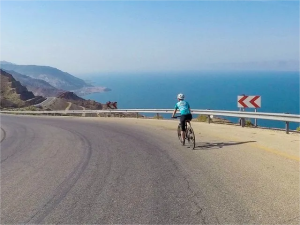10 Cool Dead Sea Facts – Salt of the Earth
- by Mohamed Adam

10 Cool Dead Sea Facts
Where did the Dead Sea come from?
The Dead Sea is part of the Great Rift Valley system which stretches from South Africa to Turkey. Some 25 million years ago plate tectonics caused the African Plate and Arabian Plate to diverge, creating the Great African Rift Valley. Tectonic plate movement continued and from 23 million to 5 million years ago the Arabian Plate and Eurasian Plate began scraping by each other creating the Jordan Rift Valley
Why is the Dead Sea so salty?
Around 4 million years ago, the Mediterranean Sea overflowed into the Jordan Rift Valley during flooding events, creating the Sedom Lagoon. With nowhere for the water to go, the saline lagoon water evaporated leaving layers of salt and other minerals. Over 2 million years. The layers of salt and minerals thickened to a respectable 2.3 km. The Dead Sea salinity is over 9 times that of the earth’s oceans.
The Sea that changed its name
A tectonic uplift, occurring 2 million years ago, sealed the Jordan Rift Valley from the Mediterranean Sea resulting in the first prehistoric lake known as Lake Amora. After several glacial and inter-glacial sequences, Lisan Lake formed and existed between 70,000 and 14,000 years ago. The Jordan River, originating in the uplifted Anti-Lebanon Mountains, flowed into the Lisan Lake from the north.
What is the Dead Sea?
About 12,000 years ago the flow of the Jordan River lessened causing the reduction in the volume of Lisan Lake. Eventually two separate bodies of water remained in the deepest localized sections of the Jordan Rift Valley; the Sea of Galilee to the north and the Dead Sea to the south. The Jordan River flowed out of Sea of Galilee and terminated at the Dead Sea.
Can you swim in the Dead Sea?
Finishing our cycling at a small resort on the shores of the Dead Sea, we donned our bathing suits and ventured down a switchback trail to the shores of the Dead Sea. We then carefully walked a short way into the sea and gently laid back into the water. We were strictly warned not to swim or splash so to avoid the highly saline water from getting in our eyes. In a less than relaxed state, I gently lowered myself into the water. The nervousness disappeared with the incredible feeling of floating so high in the water like a cork.
The Dead Sea is one of the saltiest bodies of water on earth with a current 34.2% salinity. This creates incredible buoyancy and you feel like a bobbing beach ball when floating in it. Dead Sea salt and Dead Sea mud are thought to possess fantastic therapeutic properties and is sold worldwide.
It is said King Herod had his own health spa on the shores of the Dead Sea. The earliest known name for the Dead Sea was the Sea of Salt (from biblical scriptures).
What does asphalt have to do with the Dead Sea?
A name given the Dead Sea long ago by the Greeks, was Lake Asphaltites. One of the unique Dead Sea facts, is a consistent production of asphalt which naturally floats up from the sea floor. Evidence in the area from the early Neolithic Age (9,000 years ago), shows use of asphalt for sealing baskets and decorative purposes. The Egyptians began importing the asphalt for use in their mummification process some 4,500 years ago.
How deep is the Dead Sea?
The Dead Sea depth is 304 metres (997 ft) and holds the record for hypersaline lakes as the deepest in the world.
The Dead Sea sits 430 metres (1,412 feet) below sea level, the lowest land elevation on earth. Unfortunately, it has been breaking its own record consistently for several years. In the early 1960s, Israel built an enormous pumping station on the shores of the Sea of Galilee to distribute fresh water throughout Israel. In the 1970s both Jordan and Syria followed suit by diverting water from a key tributary of the Jordan River. The result has been a 90% reduction in the required water to keep the Dead Sea’s level stable.
In addition, minerals are being extracted from the Dead Sea water through evaporation ponds in the south end of the sea. The combination of all these events have resulted in the Dead Sea’s water level currently dropping one metre annually.
In 1930 the surface area of the Dead Sea was 1,050 square kilometres (405 square miles). By 2016 the area diminished to 605 square kilometres (234 square miles).
It is speculated that the Dead Sea, if left unchecked, will lose another one-third of its volume before reaching a new equilibrium due to the ever-increasing salinity (which impedes evaporation). In other words, the Dead Sea will get saltier, but it won’t dry up!
Several options are being considered to halt the Dead Sea shrinking process. These include very improbable options such as slashing the extraction of fresh source water, introducing desalinated water from the Red Sea, and taxing industries for mineral water extraction. There is a project underway however, that will pipeline desalinated water from the Mediterranean Sea into the Sea of Galilee.
A Holey Place
A major side effect to the shriveling Dead Sea is the recent proliferation of sinkholes around the sea. To date, over 3000 sinkholes have been identified. As the water recedes, fresh groundwater dissolves the underground salts causing the land to collapse. This is posing serious risk to land, buildings, and people.
On a brighter note, those who expire from a sinkhole get it as their namesake. The only other place we’ve come across this naming of the dead is the Grand Canyon, where the rapids are named after those that didn’t survive.
The longest salt cave in the world
At the southern end of the Dead Sea, under Sodom Mountain in Israel, the longest salt cave in the world (Malcham Cave) has been discovered, at 10 kilometres (6 miles) in length. What’s impressive is salt caves are rare because pure salt formations typically dissolve before reaching surface due to their high solubility.
The thick salt formations under Sodom Mountain were deposited for two million years during the time of the Sedom Lagoon (explained earlier). Tectonic uplift then pushed the salt formations back to surface. Add some occasional rainwater over thousands of years, and voila, the longest salt cave.
What lives in the Dead Sea?
You have heard of the Dead Sea fish right? Just kidding.
One could then ask why is it called the Dead Sea? The Dead Sea density of salt being so high, fish and aquatic plants are unable to survive. Is there any life in the Dead Sea? Small amounts of bacteria and microbial fungi are present but let’s say it’s not a prime snorkeling destination.
All in all, the Dead Sea is a wondrous place for so many reasons, from a natural spa to historical wonders to its raw beauty.
10 Cool Dead Sea Facts Where did the Dead Sea come from? The Dead Sea is part of the Great Rift Valley system which stretches from South Africa to Turkey. Some 25 million years ago plate tectonics caused the African Plate and Arabian Plate to diverge, creating the Great African Rift Valley. Tectonic plate movement continued…




